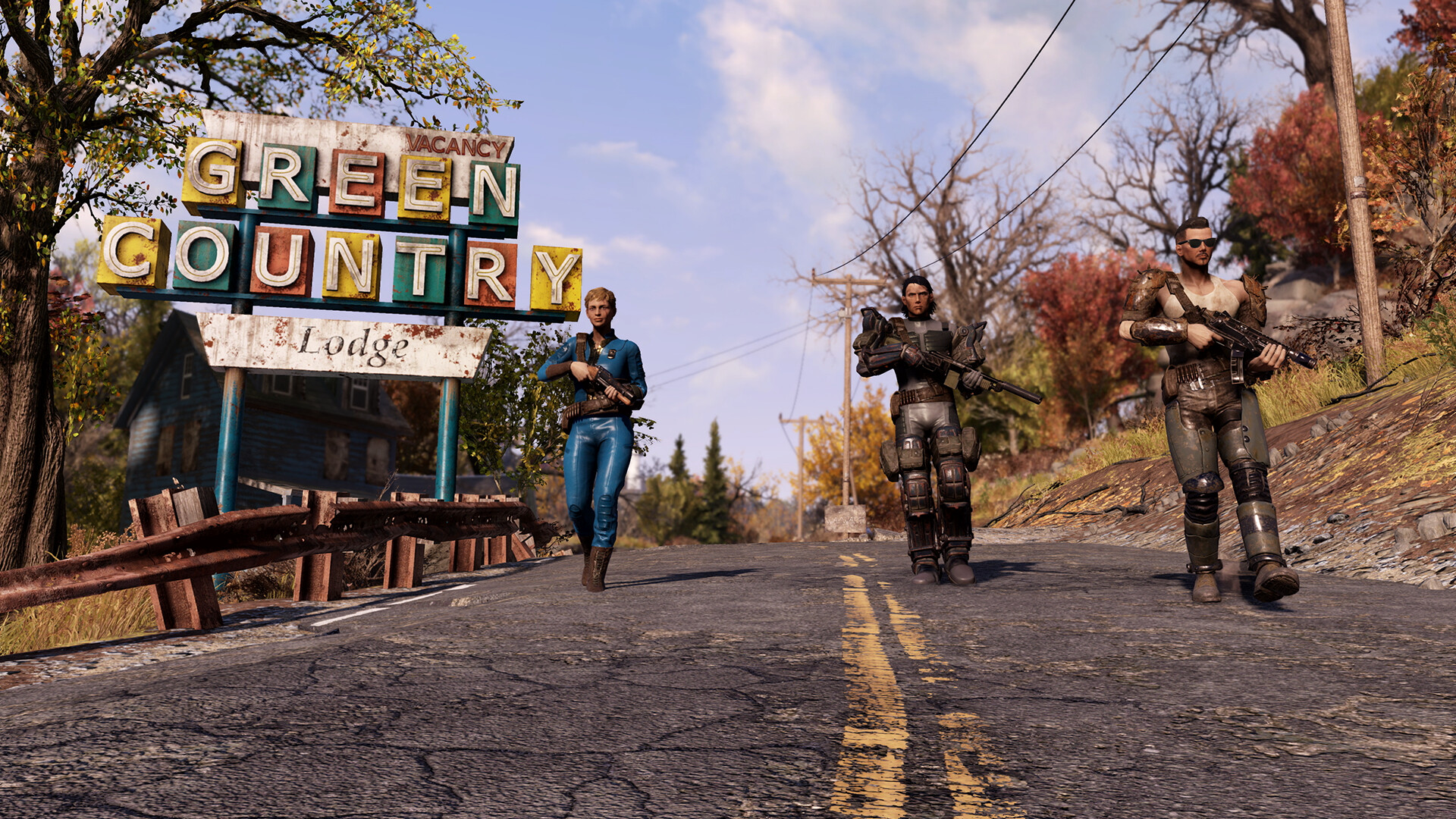
Bethesda Softworks launched Fallout 76 in 2018. Introduced as the franchise’s first foray into online shared worlds, with a focus on reclaiming a ruined Appalachia with more problems than just radiation, the response from fans was controversial. It was not moddable, and its buy-once-play-forever servers remain supported by a cosmetics shop and optional monthly sub similar to The Elder Scrolls Online. Driven by caution and curiosity, Fallout fans nonetheless picked at the new game and came up with an equally leery response.
While it was definitely a Fallout game, with eerie environmental storytelling about an empty world left behind after the bombs dropped (complete with janky code and screwy pre-order bonus controversies), the game tried its best to play on bad assumptions about humanity’s natural behaviors. It encouraged PVP, from workshop battlegrounds to tense encounters in the wild. Though you could group up for bonuses, it felt… weird to run into others. That left players with a muddled message. Are we reclaiming this place or what?
Two years later, the game’s rebirth via the Wastelanders update, with living NPCs, a reduced focus on PvP, and new storylines, provided what’s now an evolving discussion about that beautiful, load-bearing line from the Fallout series trailer. “Everyone wants to save the world. They just disagree on how.” Today we ask…well, how’s that working out for Appalachia?
Fallout 76’s Performance Is Stable But Janky
I rarely get personal about how I play video games, but I want to establish myself as someone experiencing the wasteland with you. I have 250+ hours in Fallout 76, roughly a quarter from around the Steel Reign era and the rest from January to now. Don’t ask. You know what this year’s been like.
Vaulting in from the PlayStation servers, I get an average experience compared to the PC crew. Crashes aren’t rare, but they are uncommon, and most bugs are annoyances, not game-enders. Reputedly, the Xbox version is the most stable, but they get their issues, too.
Online stability seems burdened by the game’s growth, with bolted-on expansions, expeditions, and the occasional crush from new seasons or fan-fave events. Fasnacht, a real-life West Virginia festival, is annually reborn in Helvetia, with dorky Protectrons and the promise of cool masks to collect. It also promises a non-scientifically calculated 15% chance of kicking you out of the event, killing the server, and leaving you with rat intestines clutched in your sweaty hands.
Yet we log back in and wait for the event to restart, knocking out dailies on the way. It’s a little silly that we accept the game’s lingering technical issues with the same fond annoyance as a cult classic Eurojank game, but we do. Look, the Mothman Equinox is back, and I’m going to be pissed if I don’t get the plushie plans and the Wise Mothman throne. That said, the game itself is rarely down; it’s individual server crashes and the occasional reboot-forcing glitches that slow the experience. Classic Bethesda.
Fallout 76’s Grind Encourages Microtransactions But Doesn’t Demand Them
Part of the fun in Fallout 76 is collecting materials and plans to turn your campsite into anything your ghoulified Martha Stewart heart can imagine. Throw in a vendor and you’ll lure other players over to admire your handiwork. And your giant topiary Deathclaw. My giant topiary Deathclaw. Her name is Bella.
Now, even this enjoyable side activity opens up controversial discussions about how the game is managed: Each CAMP site has a tight budget when it comes to what you can place, your stash has a tighter budget, the best plans come from the Atom shop, and the snap-kit placement rules are often funky and benefit from using glitches to merge pieces.
Some of those pains are eased by privately-instanced Shelters, which have bigger budgets and looser rules. Yet players complain, justifiably, that there’s little reason to tour other people’s Shelters – of which the best and biggest are also in the Atom shop – and that the best way to support your crafting habit is to scrape up for Fallout 1st: the game’s monthly membership.
Like ESO, there are real benefits to this: a premium currency, a survival tent utility, and other goodies. But the real swag is the Scrapbox. Unlike your stash, you can stuff junk – Fallout 4-style building materials – into this thing to your heart’s filthy content. If your membership lapses, you can still pull stuff out of it.
Unlike ESO, with that sketchy Khajiit merchant taunting you with terrible card reveals, the Atom shop is largely unobtrusive. The main menu screen casually lists it, and you’ll get a splash page when you first log in. The goodies you’ll see at other people’s camps do the rest of the job for Bethesda, and even then, the vast majority of these goodies are purely cosmetic. Stuff with tangible benefits (like Collectrons and stat-boosting furniture) also avoids the pitfalls of feeling like a pay-to-win. Versions of these are available via in-game gold bullion, and you can get the (temporary and reasonably small) benefits of the furniture by visiting a camp that has them set out for guests.
There are hundreds of players with fascinating camps who scrimp free atoms and utilize their stash smartly, so, yes, the game is perfectly playable as a buy-once experience. Do I pay for Fallout 1st? Baby, if you saw my office, you wouldn’t need to ask. But my new greenhouse camp is turning out fab.
Fallout 76’s Story Is Significantly Improved and One of the Game’s Biggest Draws
As it has since Wasteland Wanderers brought life and faction disputes back to Appalachia, further updates to Fallout 76 bring new stories – and controversies – to the land.
Expeditions, which allow visits to The Pitt(sburgh) and Atlantic City offer unique rewards, but only recently saw the latter open up for more exploration. It’s not rare for a player to ignore them, with no harm done. Daily Operations, in contrast, gives oodles of rewards, and public groups are usually opened by a high-level, power-armor-wearing wall of beef who’s chill so long as you can shoot straight and follow in-game instructions.
Meanwhile, the main story is now several main stories, intermingling to some extent. Post WW adjustments date new vault emergences forward to account for the fact that you can now meet, in person, the Overseer that put you up to this Reclamation gig. It’s still a solid storyline about the Scorched and the tough mining history of Appalachia that manages to drift you past the new Settlers vs. Raiders arc and the return of the Brotherhood of Steel.
All of these arcs – and the occasional environmental story – are up to par with the rest of the franchise and Bethesda open world games, in general. You’ll find it easy to vibe with at least one of these groups, and if you’re really hip to the lore, you’ll enjoy this early look at the BoS. Some side quests will excite you more than portions of the main plot. And the biggest joy of all is noticing a map icon you haven’t explored yet. (Psst: Bethesda horror fans? The eldritch stuff is still here. Lurking. In the deep).
A larger update later this year promises the first true map expansion, pushing southwards into Virginia’s Shenandoah, adding an excitement that’s also tempered by a change to the seasonal updates. Previously known as the scoreboard, seasonal changes rewarded regular players with free Atoms, cosmetics, plans, and other goodies as you earned points with completed dailies and weeklies.
Now simply called Seasons, your points turn into Ranks, grant tickets, open up new pages in some digital Sears catalog, and offer bonus rewards if you’re an active Fallout 1st member. Players can mostly pick and choose their rewards, skipping stuff they don’t want.
It’s an eye-catching change that resembles Fortnite’s Battle Pass method and doesn’t seem like a downgrade. However, the coolest rewards and “free” Atoms are either harder to get or locked behind membership. For many players, this change is mild. But for those careful scrimp and savers? It’s tougher than ever out there, and it’s worth hearing their complaints as we all continue to figure the new system out.
Is Fallout 76 Worth Playing In 2024?
Okay, let’s get into the dirtiest Appalachian secret of all: I love Fallout 76, and by introducing its quirks with informed caveats, I hope more gamers are willing to try the game out. Fallout 76 has one thing that I think elevates into something special: the community. It’s a community that’s eager to wordlessly help you in the game, shunning mics as an online faux pas. That’s a delight for socially anxious or exhausted players.
Meanwhile, new players are often showered with goodies and urged via emote to follow others around while they get a feel for things once they exit the vault. Even without the help, the early game experience has been streamlined, with tutorial quests offered via the Wayward Inn and the option to start at level 20 with a basic but solid perk loadout of your choice.
You won’t feel like you’re behind for long, even if you start at level 1, with the amount of exp the story throws at you, and low-level players are always welcome at popular events, so long as they’re trying to contribute. Hint: Eviction Notice and Encryptid are the hardest events that almost always draw a crowd. The former has tons of heavy-hitting super mutants and a chance of nuking everyone if they’re too busy farming for loot, and the latter is… no spoilers for the replayable finale of one of the best side quests in the game, but that thing is pissed. The general rule is that you shouldn’t think you’re going to solo events labeled as Hard until you have a good late-game kit.
Fallout 76 also has a community that rarely turns on itself, saving its grumps for feisty discussions about game performance and update changes – and the occasional jackass with a trap camp and an attitude. Even the usual harassments LGBTQ+ and female-identifying players experience are lessened. They are not gone entirely, but they are drastically reduced compared to many online game communities.
Fallout 76 is far from being Bethesda’s shiniest product, but it’s fun, it’s compelling, it’s evolving, and, most of all, it is a Fallout game. Lore slingshots from the blackly funny to the horrifying as it introduces you to the lethal joke of Mothman cultists and shocking pre-war experiments with the FEV mutagen. It’s also canon, even though how it’s faring by the time of later Fallout entries is left a mystery. It’s a living game, with a huge map to explore, and always something new to do.
The flaws that remain can’t hide this weird but cozy gaming experience, one that somehow feels more like you’re playing with neighbors, or with ordinary people just trying their best. 76 is often a solo ride, but grouping is so background natural that you’ll probably be in a team 90% of the time just for the perks.
Come on over. I’ll be waiting at the vault for you in my Moth Cultist robes and pink Brahmin backpack. With all the ammo and fly hats you’ll need to start exploring this troubled but beloved wild waste.
The post Is Fallout 76 Worth Playing In 2024? appeared first on Den of Geek.







